Papua New Guinea
Crossing the Indonesia-PNG Land BorderCrossing the Indonesia-PNG Land Border
For some reason, there seem to be more blog articles about crossing this border than any other aspect of visiting Papua New Guinea (PNG). They’re not all accurate though, so I’m adding my two cents to clarify the requirements and hopefully make everyone else’s life easier. Crossing the border is not difficult if you’re well prepared. Or at least, it shouldn’t be, but luck was against me this time.
The PNG Embassy in Jakarta
I had done my research and prepared all the required documents. PNG’s embassy in Jakarta is one of the few embassies I’ve dealt with that actually has a very good and (shock, horror) up-to-date Web site. Citizens of most countries require the following documents:
- Photocopy of passport identity page
- 1 x passport size photo
- Onward flight tickets
- Intended itinerary in PNG
Only the last item on the list is a little tricky, as they don’t specify what is required in terms of an itinerary. They seem to prefer plane tickets into the country (or to West Papua if entering by land) as well as out, but there was no mention of hotel bookings or anything else.
I was so well prepared that I even had a copy of a bank statement showing that I had sufficient funds to cover my trip, but I never actually needed it (I had it prepared anyway for the Timor Leste visa, which did require it). I arrived at the embassy in Jakarta on Monday morning, thinking that if the four-day processing time mentioned on the Website was accurate, I could collect the visa on Friday and fly to Bali on Saturday to visit a friend, then on to Jayapura in Indonesian Papua the following Monday. Alas, it was not to be. The embassy is on the sixth floor of an office building and the security guards downstairs told me it was closed. They had no idea why and weren’t even sure whether it would be open the next day. Great!
The next day, I went back and my luck turned. I walked straight in and a solemn but very helpful lady took my application, looked suitably impressed that I had all the documents, and then asked me whether I had my flight to Jayapura in West Papua booked yet, because they needed the tickets to show my itinerary. I said I hadn’t booked the tickets yet, because I didn’t want to book non-refundable tickets until I had the visa, and showed her a letter I’d written to the embassy, which summarized my itinerary step-by-step. I’d also included a couple of lines stating how much I’d heard about the beautiful country of PNG from friends who’d visited and how much I wanted to see it for myself. I find this works wonders with many embassies – how can you refuse a visa when someone is so passionate about visiting your country? They’ll have a really bad impression if you do!
The lady said she wasn’t sure whether the letter would be accepted or not, but she would submit it to whoever makes the decision and see. I told her that I hoped to fly to Bali at the weekend and asked whether I could collect the visa on Friday, even though that was only three working days processing time, as they had been closed the day before. She told me that the previous day had been PNG’s independence day, so of course I congratulated her on it. She smiled, gave me a phone number, and told me to call her on the Thursday morning to find out the situation.
On the Thursday morning, I called the embassy and was told that the visa was ready for collection! I went straight there and was very impressed to receive it after just two working days. The visa has 60 days validity and is completely free, much better than most countries in this region, which generally only give 30 days (including Indonesia). PNG is large and diverse and land travel times can be painfully (sometimes literally, as I would find out) slow, so the 60 day limit gives a bit of flexibility.
An Epic Journey to the Border
I flew from Bali to the Jayapura region of Indonesian West Papua, intending to stay two days just to have a look and then go on my way to PNG. Jayapura, and especially the beautiful lake Sentani, turned out to be far more interesting than I expected, and I had a really great time hanging out with Nesty, my Couchsurfing host, so I ended up staying for eight days before finally attempting, and unexpectedly failing, to cross the border.
The journey to the border was epic. Nesty drove me from the village of Doyo Baru, where she lives, to Sentaini on the back of her motorbike. I then took a minibus for 7,000 rupiah (€0.41/$0.44) to a bus depo called Expo on the road to Jayapura City. From there, I took another minibus to Abepura bus terminal for 5,000 rupiah (€0.29/$0.32). Unfortunately, the busses eastwards from Abepura don’t leave from the same terminal, and I didn’t find any buses between the terminals, so I took a taxi (which was actually still a minibus, but carrying only me) to the Yotefa Pasar market where the other terminal is. I usually avoid taxis due to cost, but it was only 5,000 rupiah (€0.29/$0.32).
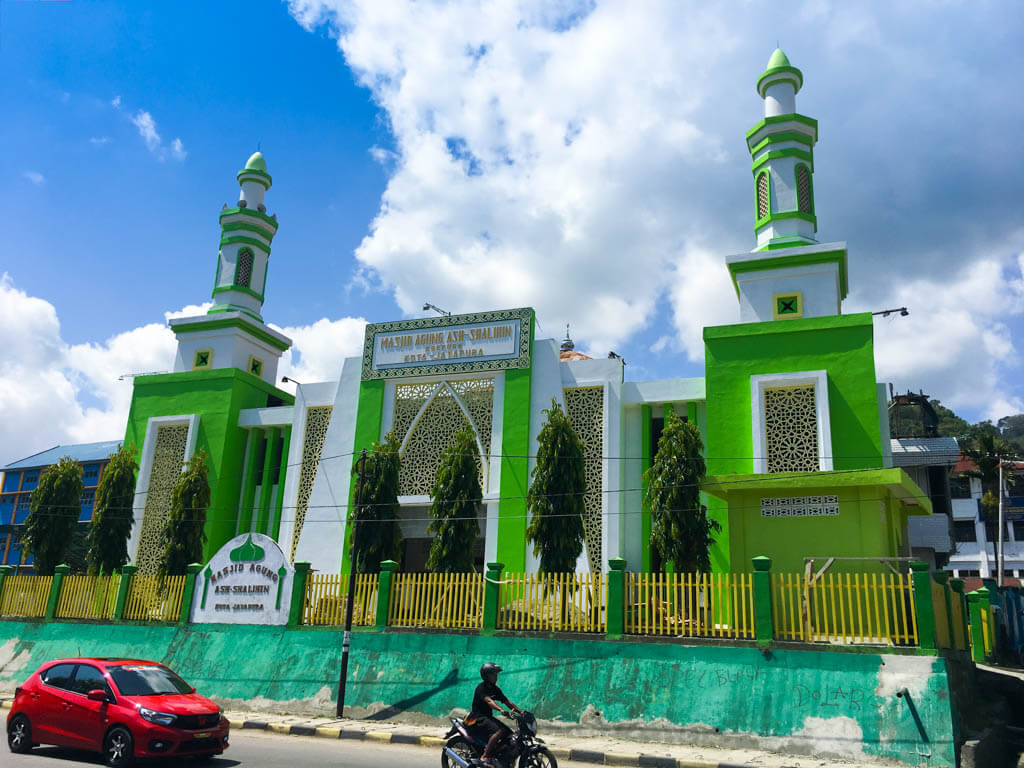
Papua is traditionally Christian, but the Indonesian Muslim influence is very evident, as with this mosque in Abepura
At the entrance to the market, I stopped for some chit chat with a very friendly security official who directed me to the eastern end of the market to catch the bus. The ‘bus’ turned out to be a very old beaten-up pickup, which took me to a village called Koya Barat, at which point I realised that it actually went one village further to Koya Timor (East village), so I stayed on until we arrived there. This one was expensive – 12,000 rupiah (€0.71/$0.76)! Koya Timor was the last point on the route with buses. To get to the PNG border I still had 2km of backroad leading to the main highway and then another 20km along that.
I started walking and stuck out a thumb at every passing car. People kept asking me if I wanted to hire an ojek (motorbike taxi), but I refused. After about 10 minutes, a truck stopped and I hopped in. The driver didn’t speak much English, but was very friendly and took me to the main road, where I walked a bit further and, after about 20 minutes, flagged down a car. I asked the driver if he was going to Skouw, the border village on the Indonesian side. “Yes yes, get in,” he said. But then 20 minutes later he stopped and asked me to get out only halfway to the border, before driving off in another direction. Looking at Maps.Me, I realised that there are actually two villages on the highway called Skouw – the one at the border and the another one where I was now. Way to confuse the (admittedly few) tourists! I walked to the edge of this Skouw and hitched a ride with another truck, which finally dropped me at the border. The whole journey took about four hours – not too bad really. Finally, I was going to enter the mystical country of PNG. Or so I thought.
I had brought 1m rupiah (€61.16/$68.31) with me to the border, because I’d read that there are no ATMs on the PNG side and wanted to have some PNG kina in cash in case of any problems with bank cards later on. After getting down from the truck, I found a small local restaurant and got some lunch, which came with a free drink. It turned out that they also changed money, at 4000 rupiah to the kina, which, after doing some calculations and comparing it to the rate on xe.com, seemed like a pretty good deal, so I changed the 1m rupiah. I paid for the meal, but apparently the drink wasn’t free after all! An argument ensued, but I stuck to my guns and eventually the lady on the checkout said okay and dropped it. However, I still had 129,000 rupiah to change and didn’t feel like changing it with her anymore, so I kept it and headed toward the border crossing anyway.
At the entrance to the courtyard where the border station is located, I met a Polish couple who’d just crossed from the PNG side. We stopped and chatted for about 10 minutes and they told me about how they’d travelled in PNG for three weeks staying with local people and using public transport, and how it wasn’t nearly as expensive as people say. Apparently, I was really lucky, as the border had been closed on the previous two days due to some security issues and had only reopened that morning. They had been camping out at a local’s house on the PNG side waiting for it to reopen. They gave me their PNG SIM card and I gave them my Indonesian one, as I wouldn’t need it anymore. We said our goodbyes and I left them, arriving at a small bank branch, where I changed every last Indonesian rupiah I had to kina, even though the rate was slightly worse than at the restaurant.
Finally arriving at immigration, where I was the only person crossing, I gave my passport to the immigration officer, who asked a couple of standard questions, and then stopped to answer his phone. When he hung up he handed me my passport and said, “You must leave, we have a security issue, it’s not safe here,” and all the immigratoin staff and I traipsed outside the building. We waited for about twenty minutes until we were allowed back in again, but then I had to wait for the PNG side to reopen before they would let me through. I could see the gate through the big glass doors on the PNG side of the building. It was maddening – we waited and waited, and the immigration officers called their counterparts in PNG, but no one answered.
A friendly officer told me that this had happened three times in the last 2 weeks and that they’d never seen any evidence of an actual security threat! Each time the PNG offiers called them to say there was an incident and closed the border. Sometimes it would stay closed for days with no explanation. I hung around for an hour, until it seemed clear it would not reopen that day. Luckily, the friendly officer gave me his WhatsApp number, so that I could message him and find out the situation the next morning before I came all the way back to the border again.
I had to go back to the bank and use the ATM to get more Indonesian rupiah, as I’d changed all of mine to kina. It was already 3pm by then and there was almost no traffic on the road heading back towards Sentani, so hitchhiking could be difficult. I couldn’t even send Nesty a message to let her know what was happening, because I’d given my SIM card to the Polish couple. Despite all of this, I ignored all the people offering ojeks and taxis and waited by the road on the off chance of finding a car to flag down. In half an hour, only 3 cars passed. The first two ignored me completely, but the third one, a pickup, stopped. I hopped into the tray at the back with a teenage boy who was also riding there and it turned out I’d hit the jackpot – they took me all the way back to the Expo bus terminal.
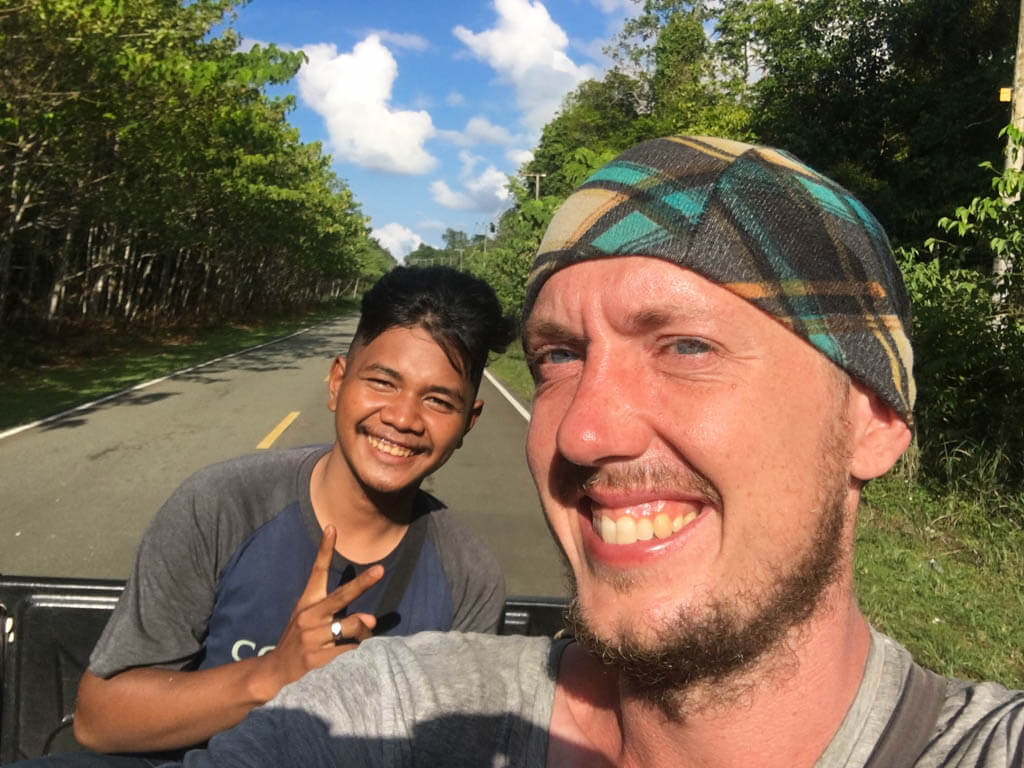
I made a new friend on the way back from the border
The teenager didn’t speak much English, but was very friendly and we managed to communicate a bit with his English, my few words of Indonesian and a lot of pointing and gesturing. The scenery was beautiful, as we took the main road along the edge of the lagoon near Jayapura City and I got an excellent and unobstructed view from the back of the pickup. So, despite my failure to cross the border, the day was not wasted. After they dropped me at Expo, I got a minibus back to Sentani and my (very surprised) Couchsurfing host’s office (just as she thought she’d finally got rid of me…).
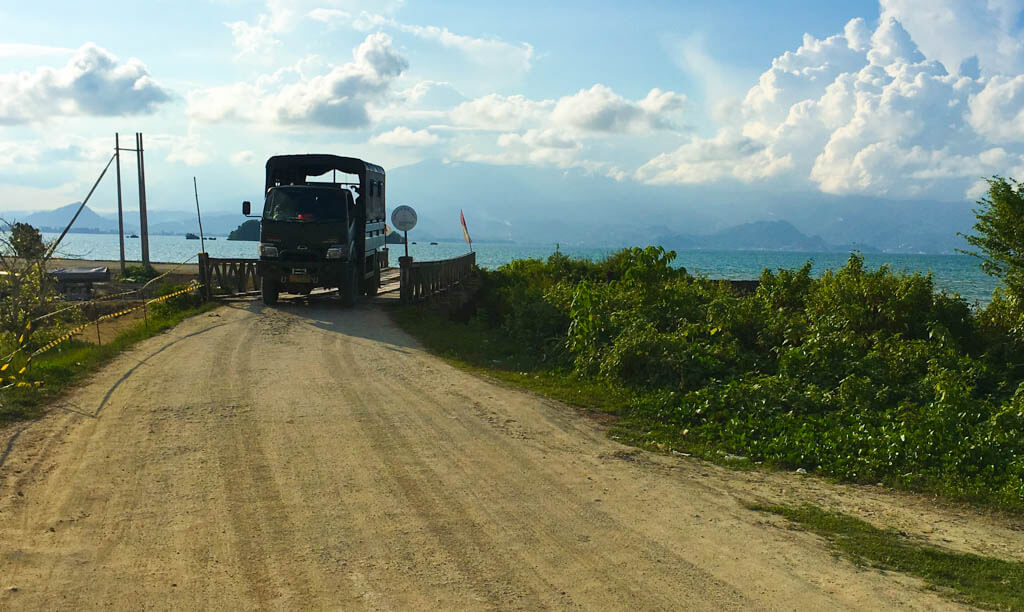
I took several photos of this truck approaching across a bridge before realising it was a military vehicle. One of the golden rules of travelling in sensitive regions is never to take photos of anything military. Fortunately, they either didn’t notice or didn’t care.
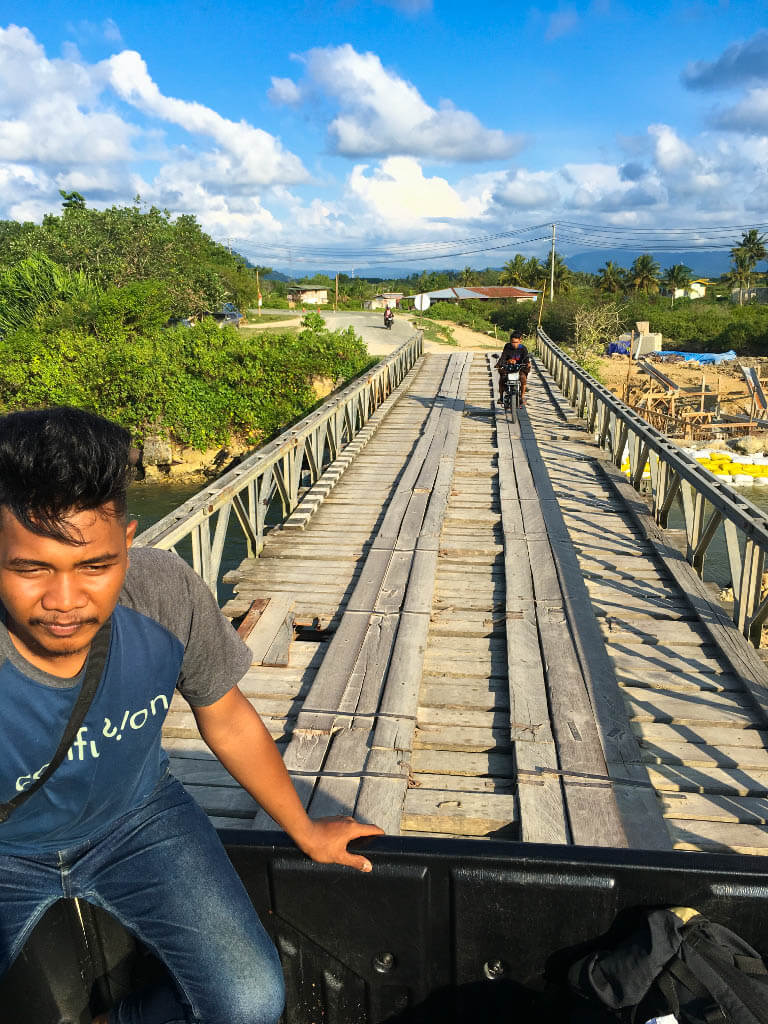
The weather was gorgeous and the Papuan countryside is beautiful
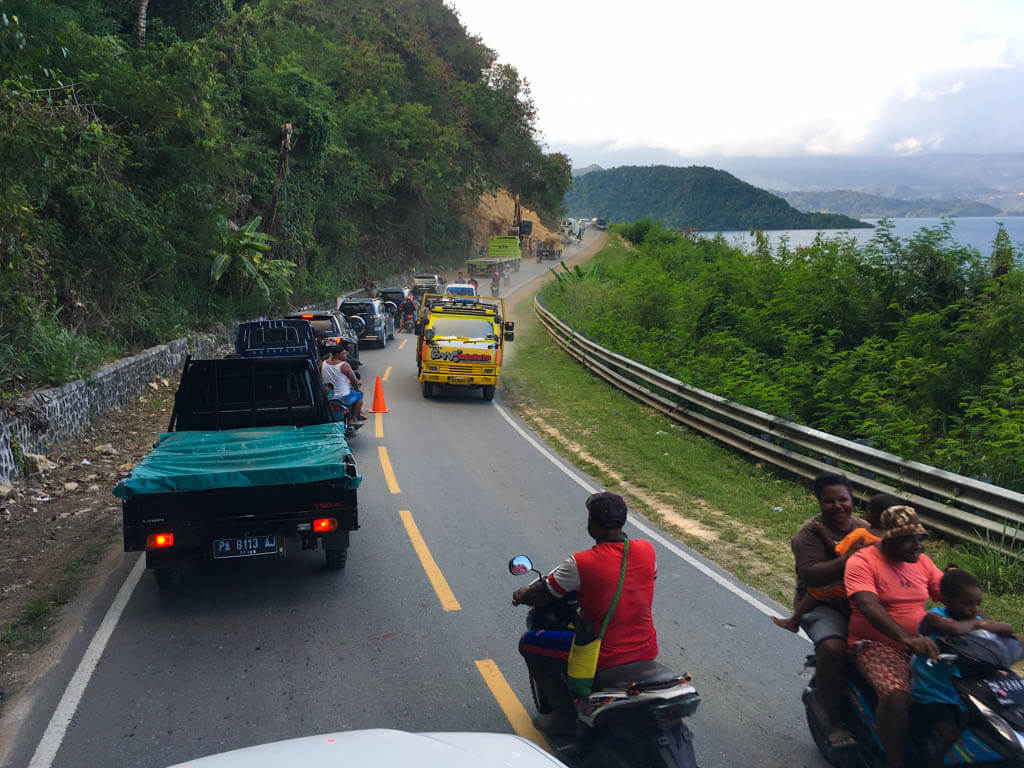
Traffic jam by the end of the lagoon.
The next day was Friday and I got up early to check WhatsApp, but the immigration officer told me that the border was still closed. Nesty invited me to go with her and her friends to a beach by the coast for the weekend, so I decided to give up on the border for the weekend and try again on Monday. I also checked plane tickets in case the border didn’t reopen before my Indonesian visa expired the following Friday. There are no international flights from Jayapura and PNG has no other land borders, so I’d have to enter by air by flying Jayapura-Bali-Singapore-Port Moresby, at a total cost of €700 ($750), and then do my planned route in reverse! Not really an option, so I’d just have to find a way to cross by land the following week.
After an amazing weekend camping on a West Papuan beach with Nesty and friends and having my toes bitten by wild pigs, I got up early on the Monday morning and repeated my trip to the border. I was determined to give it my best shot, so I didn’t even bother asking the immigration officer about the border situation on WhatsApp.
The ride was smooth this time, as I already knew the route. In the closed-back pickup from Yotefa market to Koya Timor, I was squeezed in the back with 5 people, one of whom had several plastic carrier bags containing cans of paint. He got off part way through the journey and one of the bags had split, so I helped him with the cans. He said thank you, smiled at me, and asked me where I was going. I told him, thinking nothing of it, but before I knew it he had paid the driver for my journey as well as his own! The kindness of the people I meet while travelling never ceases to amaze me.
I arrived at the border to find it open (lucky, as I later found out that it had been closed all weekend) and went straight across without stopping to eat or change money. The Indonesian immigration officer stamped me out without asking any questions except whether I was coming back the same way (I said no). Arriving on the PNG side, there was a counter with an official behind a desk in a metal shed and two entrances separated by a fence with no signage. I took the left one, which turned out to be for people leaving PNG, and was very politely redirected to the right one. I completed a customs declaration form and the officer checked my visa and stamped my passport. I then walked around the side of the shed to the customs desk and handed the officier my completed declaration. I told him that I had one packet of biscuits in my backpack, which I hadn’t mentioned on the form despite it asking if I was carrying confectionary and he told me that was fine and there was no need to open my bag. With that, I walked out into PNG. Easy!
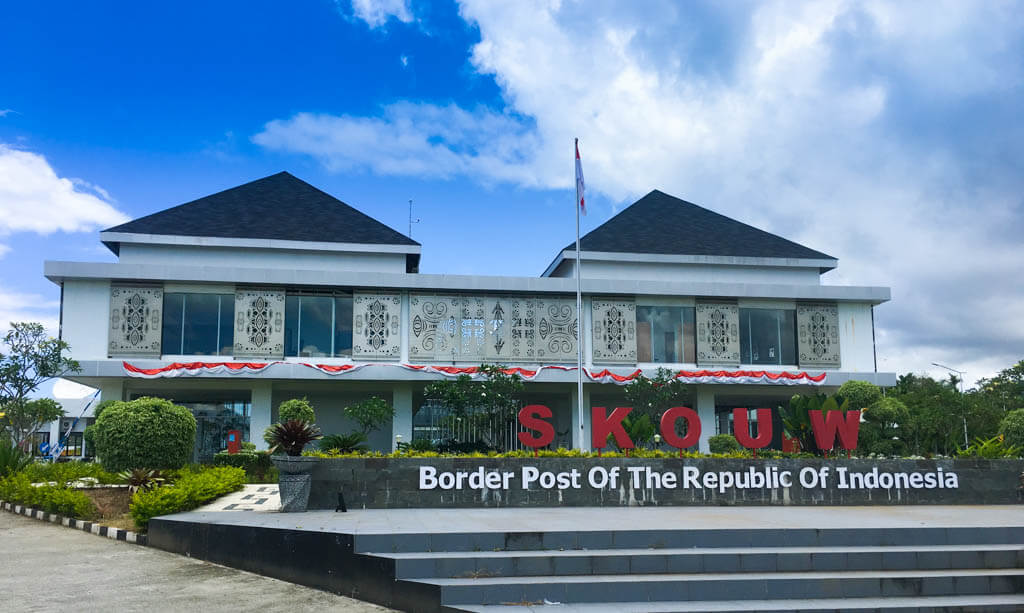
Sneaky photo of the Indonesia-PNG border control post from the West Papua side. I don’t usually take photos of border crossings, but there was no one around to object.
Arriving at the car park, I found a bus and asked a couple of people whether it was going to Vanimo, the first real town on the PNG side, about 45km away. It was, but it was full. I was about the wait for the next one, when a rather pale (by PNG standards) man asked me if I was travelling solo. I said yes, and he told me they had space for one person and to get in. I asked him the price, and he said 10 kina (€2.61/$2.93), close enough to the 8 kina (€2.09/$2.34) I’d read about in a blog article that might have been a bit out-of-date. After about 1km, the bus stopped and all the foreigners, which turned out to be everyone on the bus, had to get out and have our passport details noted down by two very friendly soldiers. I chatted with them a bit and was quite surprised when they told me that on average 7-8 backpackers a week come through this route.
My passport was checked and, while I waited for the other passengers, I chatted with the man who’d offered to take me on the bus for a minute. It turned out that he was from Malaysia – no wonder he was pale! “Do you speak Chinese?”, I asked him, in Chinese. He looked really surprised and we continued to chat in Mandarin (it’s surprising where in the world Chinese language skills come in handy!). It turned out that he was working in PNG and was bringing a group of Indonesian workers into the country with him (the others on the bus). When I asked what he did, he looked slightly embarrassed and said it’s great meeting you, don’t worry about the 10 kina, the company pays for the bus anyway, no need to pay me, and ended the conversation.
Later, I heard that a Malaysian company was carrying out large scale logging in the area, so reading between the lines, I think the Malaysian guy worked for it and probably realised that many westerners have a bad perception of such activities in native forests. Anyway, I got my second free ride of the day and the bus dropped me conveniently in Vanimo, next to the extremely overpriced Vanimo Beach Hotel, starting at 270 kina (€70.33/$78.87) a night for a grubby single room. I left immediately to look for something more suitable for my budget, but that’s another story…
More Stories from Papua
I spent five weeks in Papua New Guinea and it was one of the most amazing travel experiences of my life. I hung out with local tribes, squeezed with 25 people into the tray of a Land Cruiser and risked my life on the stormy seas. Here’s my first article about it:
On Rough Seas – Vanimo to Aitape
I also spent a beautiful twelve days Couchsurfing in the fairy tale land of West Papua before crossing the border to PNG. If you’d like to hear about my adventures there, chasing dreams around lake Sentani and getting mistaken for a tasty snack by wild pigs on the beach, check it out here:
West Papua: The Lake Where Dreams Come True
Useful Tips
- Visa on arrival is available at Port Moresby International Airport and Tokua airport near Rabaul on New Britain island, but not at the land border with Indonesia. However, the full visa is easy to obtain and free from the PNG diplomatic missions in both Jakarta and Jayapura City.
- Flying to Jayapura is generally much cheaper than flying to Port Moresby. This is especially true if, like me, you want to visit the Sepik River region of PNG, as there are no roads connecting Port Moresby with the northern half of the country. If you fly into Port Moresby, you have to either take the ferry to Lae and then travel by land/water for several days or take domestic flights to reach Wewak, the coastal town that is the get-in point for the Sepik river. In contrast, after you cross the border from Jayapura, getting to Wewak is a case of taking a boat from Vanimo to Aitape and then a PMV (public transport) to Wewak, which takes two days (nothing by PNG travel standards). Vanimo is also a very nice town in its own right and well worth checking out.
- Vanimo is one of the safest towns in PNG, which really isn’t saying a lot, but I honestly never felt unsafe there. However, like always in PNG, keep your wits about you. Many Papua New Guineans are extremely poor and, while they are usually extremely friendly to foreigners, PNG society in general is quite violent, in most parts of the country men routinely carry machetes and alcohol is a massive problem, all of which can undermine safety.
- The people of West Papua are extremely friendly, making it a great place to hitchhike.
- West Papua, including Jayapura City, does see protests by native Papuans against Indonesian rule periodically and these sometimes turn violent. Four people died in protests in Jayapura City just before I arrived and riot police were very visible during my stay, but I never felt unsafe while I was there. Papuan people are very friendly to foreigners, so stay away from any protest sites and you’ll be fine.

Trackbacks/Pingbacks